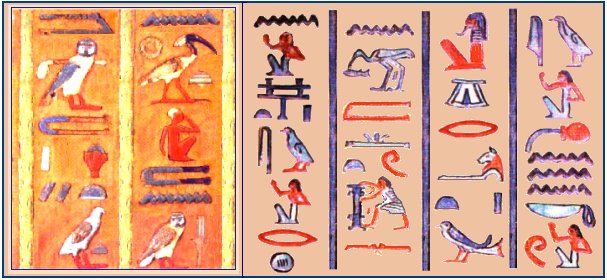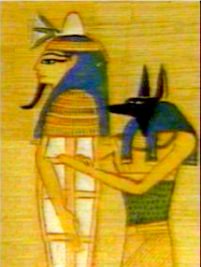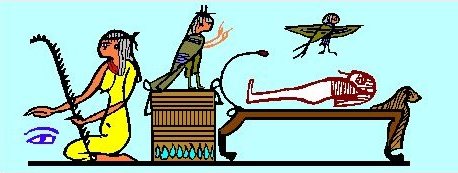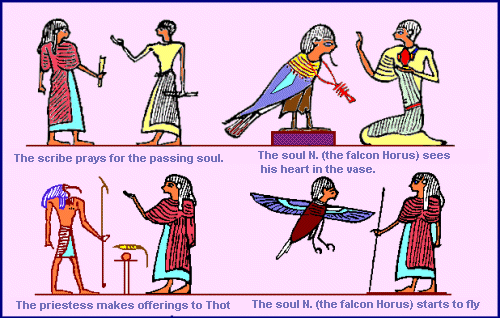
The "Book of the Dead" (and of
the Rebirth)
Or
"The
Chapters of the Coming Forth by
Day"

The Pyramid Texts
or the THE WORLD'S FIRST ILLUSTRATED
BOOK
The first (known) drawings depicting the voyage of the dead to the netherworld date back to pharaoh OUNAS (2397 to 2364BC) of the fifth dynasty, and were commonly known as the Pyramid Texts. They draw their substance on the Grand royal funerary ritual in the Ancient Empire.The spirit of these books extended into the First Intermediate Period and into the period of the "Middle Empire" (between the ninth and twelfth dynasty, roughly 2160BC to 1700BC), when they were called "The Sarcophagus Texts or The Book of the Two Paths," although most of the copies Egyptologists have discovered and classified into chapters are loosely connected to one another and have few things in common.
In the first years after 1580BC, the Book of the Dead appeared as a vast collection of formulas assembled with the help of illustrations (vignettes) that fascinate with their finesse and colors. The papyrus of Ioya (Cairo Museum) already contained 40 formulas; the Kha papyrus, written under Amenophis III, preserved at the Turin Museum, contains 33, and the Nu papyrus (British Musaum) has 137, aside from the doubles.
It was only during the Saite period that the integral Books of the Dead reappeared.
During his lifetime, an Egyptian could visit a scribe and choose the formula he would deem best suited to safeguard and protect his soul and body, and those which would procure him unimpeded access to Eternal life.
Developments during the 26th Saite dynasty (-650) opened the way back to the sources of spirituality and thus gave the Book of the Dead its definitive form, although other papyrus texts bore equally complete titles such as "Formulas for coming forth by day" or "Formulas of transfiguration and glorification in the Kingdom of the Dead."
In 1842 German researcher Lepsius copies 165 formulas from a document and calls it the "Book of the Dead." The paper is preserved to this day at the Turin Museum. In 1881, a Dutch scholar, Pleyte, adds 9 new chapters to Carl Lepsius's book. Dutch Egyptologist Adriaan A. de Buck regarded them as a single BOOK, and titled his own book, made of bits and pieces, "The Book for proclaiming one RIGHTEOUS in the Kingdom of the Dead"...
At the request of the "Second Congress of Orientalists" in London, on 19 September 1874, Swiss Egyptologist Naville published what he called "the BIBLE of ancient Egyptians." Naville's publication came out in print in 1886. In 1898, British Egyptologist Sir E. A. Wallis Budge in turn prints his own publication of chapters of the Book of Dead under the title "Chapters of the COMING FORTH by DAY."
The expression "coming forth by day" or "coming forth during the hours of sunlight" is the supreme desire of the deceased man to join the number of the blissful who merge with the sun, the "symbol" of life.
Ever since the Ancient Empire, the sun, its light and warmth, have become the source of life and the symbol of human protection. After death, a man has but one goal: to join the light and melt with it and into it. In the 18th century Book of the Gates, the god Ra crosses in his boat the twelve (hours) divisions of the night, through Ossiris' court of judgment, and is reborn on the other side of the Nile...
Like the Ba, this bird with the human head which represents (the spirit) the spiritual side of man and gods (also designated by the sign of the ram, which is also the sign of the god Khnoum, who fashioned the first men on a potter's wheel with clay...) The Ba becomes the divine spark that dwells in a man and leaves him upon death, soaring, like its bird symbol, to join its true home in the sky. In fact, one finds in chapter 85 the first verse of St. John's Gospel: I am the Eternal... I am the Word which IS before the scripts...
In the Egyptian polytheism, the same person is invoked under different names in different places, the same God in various representations... In the Egyptian mortuary ritual, chapter 37, various parts of the dead body are identical to those of the Great God, each representing the associated deities, so that none is deprived of the Supreme Being. As the dispersed parts of Ossiris form a single body, that of the invisible Great God is made up of multiple facets:
" my true form is concealed within me, for I am the unfathomable… "
As a living animal can be a god's Ba, a man can also appear in the animal form of a god's Ba and become the falcon of Horus or the ram of Amon-Ra. During a brief portion of space-time, life takes the bodily appearance of various forms that transmute by embracing, over the long road to death, the many successive countenances (even those of some animals) which the soul N. will bear during its lengthy voyage toward eternal life. Similarly, some Oriental religions hold that the dead embrace various new countenances in the changing cycle of life that resembles a turning wheel...
As the dead Ossiris, bisected and dispersed in the many regions that make up Egypt, the god reconstructs himself to defeat death and preserve himself from destruction, to become Ra, the light and the life that attracts every soul that longs to follow it in the process of eternal rebirth.
Ra and Ossiris are seen as one person which becomes the incarnation of Justice and truth, the reflection of Maat, the goddess of Justice and truth - the foundations of cosmic order and peace on our tiny planet and probably on countless other worlds where life exists and evolves...

The dance of Anubis

The Osiris N and the god Anubis
The most beautiful quotations from the "Book of the Dead"
To better understand the passage from death to life, we have picked several excerpts from those which are most eloquent and provide the best image of Egyptian spirituality
CHAPTER 1 (excerpts) - Formulas for the burial day:
- I am Thoth (god of wisdom) o Ossiris, bull of the West, king of Eternity, I am he who proclaims Horus (your son) righteous against his enemies, in this day of judgment in the Great House which is in Anu...
- O ye who make perfect souls to enter into the House of Osiris, ye who open up the way to perfect souls, open ye up for my soul the way for I have departed here with no sin found in me, I have not depressed the pointer of the balance with any evil deeds...
- It was inspected and his soul was confronted with him, his mouth was found righteous on earth. There, before You, Master of gods, he arrives in the land of the righteous and appears glorious as a god. He shines as an ennead which is in the sky, his stride soars to the heart of the cult of Atoum-Ra and he beholds the venerable Orion. He climbs into the boat of Ossiris and is not pushed back, for he is with his Master...

Prayers for a soul (N.) entitled to ascend to the heavens
Note: the soul N. symbolizes here the souls of righteous kings and those who have been found pure and just among the souls of people during their stay on earth.
CHAPTER 7 - formula to avoid the evil serpent Apophis (uttered before a wax figurine representing evil, which is later destroyed and burned):
- O ye who seizes (the souls) and takes them by violence
- O ye who lives of those who are inert, thy poison shall not enter into my limbs of Atoum.
- I am Atoum in the Noun, my safeguard is made of all the gods eternally.
- I am (becoming comparable to Atoum,) one whose name is secret…
CHAPTER 9 - formula for opening the cave:
- " O thou mighty soul of terror. Behold, I have come unto thee. I see thee. I have forced a way through the Tuat. I see my father Osiris. I drive away the darkness. For I am his Beloved, I have opened all the ways in heaven and on earth. I am a son beloved by his father, here I am, a memorable, a blissful...
- O (ye): all gods and all blissful, force the way for me, for I am Thoth who rises."
CHAPTER 11 - formula against the enemy of the Kingdom of the dead:
- I (have become) Ra and am risen in the horizon against my enemy. I am set up in Horus, I am in my becoming in Ptah, I was valiant in Thoth, I was powerful in Atoum, I wave walked with my legs and spoken with my mouth. It has been given to me and it will be not taken from me.

CHAPTER 15 salutations to Amon-Ra who sits in Heliopolis (and in Thebes) :
- " Hail to thee, Amon-Ra, the greatest in the sky, the Master of that which exists, (thou) who establishes durably everything "
- O Amon-Ra, master of the horizon! O thou art beautiful, thou shinest with splendors…
- Thou rejoineth thy limbs (as Osiris) and thy body reviveth.
- Hail to thee Ra-Horakhty (Horus in the horizon, where the sun is in zenith - the god at his mightiest powers). Thou shinest in splendor, thou art radiant, thou risest. Thy name is noble and thy power is divine.
- Let all gods and all goddesses bring worship to Amon-Ra-Horatkhty.
- Send thy light to the entrance of my tomb, permeate my body with your essence.
The passed and pure soul becomes a double or part of Osiris (it is henceforth called Osiris N.)
The Osiris N. has crossed the sacred isle, he has seen the god in the Noun (the primordial Ocean), he has returned thanks to the flood... I am your favorite amidst people, I am he who brings truth to Ra and who repeats the truth to Atoum…
- Hail to thee Ra, master of Maat, who sits in the chapel, master of the gods! Rescue N. of vile enemies as Ra hath been liberated (in the morning) of the vile enemy Apophis (the king of lie, murder and darkness).
- Hail to Ye: Ra, Khupriu (scarabee - homonym for becoming), Atoum (the great invisible God of Heliopolis), Horakhty, magnificent and sacred falcon who delights the land by his beauty...
- Acclaim to thee, o king who knows eternity, king of eternity!...
- Hail to thee who hast been the same BEFORE thy birth and before uttering thy name,
- Hail to thee who hast the eyes open as thou walk the way of eternity!
- Hail to thee as sayeth your Ka when the scepter of command is in your fist, o Atoum!
- Hail to thee as sayeth thy worshippers who are the guardians of Heaven!
- Hail to thee who risest bright above the lotus and shinest on the leaf of the lotus.
- God who purifies himself, who works the day. God whom people ignore, God who crosseth the sky and is one with it, God unique, living soul who sits in Heliopolis, bearer of Maat, who offereth us his existence (justice and truth), who acts by her, she who worships you and reveres your main names.
- Hail to thee, Ra when he sets, Atoum-Horakhty (Horakhty = Ra in sunrise)
Divine god who has come into existence by himself,
Primordial god who existed before the beginning!
- Acclaim to thee, God who hath created gods, who raised the sky to be the course of his two eyes (sun and moon), who hath created the earth to be the land of thy splendor and makest each know his or her partner!
- The venerable dead are in jubilation when thou shinest there for the great Ossiris, regent of eternity.
![[Image]](pict0.jpg)
Formula for the secrets of the mysteries of the kingdom of the dead:
- To see the solar disk when it sets in the West and worshipped by the gods and the blissful of the Tuat. To transmute the blissful (the dignified deceased and future Ossiris N.) into the heart of Ra. Make it powerful before Atoum and magnified before Ossiris, affirm his prestige to the gods of the Ennead (group of primordial divinities) which rules the Tuat. To maintain his heart and extend his stride whilst opening his face as that of the great God so that all transmutations he desires may come forth in full day.
- He shalt be powerful among the gods of the Tuat who shalt recognize him as their own and he shalt enter through mysterious gates, like a force...
- Hail to thee (deceased chosen soul) and welcome! The eye of Atoum is next to thee and it wraps you in your protection when thou crosseth the sky and when thou arriveth on earth having conveyed the light...
- Thou art risen in the sky, thou hast crossed the celestial waters, thou art seen with the stars...
| Return to homepage |
o - o - o - o - o - o